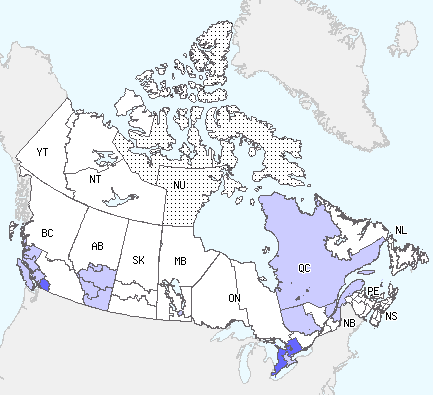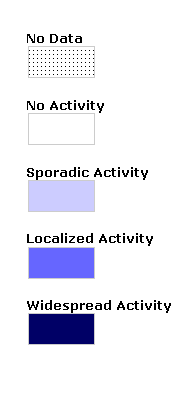FluWatch report: October 5 to 11, 2014 (Week 41)
Overall summary
- Influenza indicators (activity levels, influenza detections, ILI and hospitalizations) in some regions across Canada continued to increase in week 41.
- So far this year, the H3N2 has been the most common strain affecting Canadians.
- So far this season, the majority of influenza laboratory detections and hospitalizations were in seniors ≥65 years of age.
Are you a primary health care practitioner (General Practitioner, Nurse Practitioner or Registered Nurse) interested in becoming a FluWatch sentinel for the 2014-15 influenza season? Contact us at FluWatch@phac-aspc.gc.ca
On this page
- Influenza/ILI Activity (geographic spread)
- Influenza and Other Respiratory Virus Detections
- Antiviral Resistance
- Influenza Strain Characterizations
- Influenza-like Illness (ILI) Consultation Rate
- Influenza Outbreak Surveillance
- Pharmacy surveillance
- Sentinel Hospital Influenza Surveillance
- Provincial/Territorial Influenza Hospitalizations and Deaths
- Emerging Respiratory Pathogens
- International Influenza Reports

Download the alternative format
(PDF format, 455 KB, 10 pages)
Related Topics
Influenza/ILI Activity (geographic spread)
In week 41, the majority of regions in Canada reported no activity; however, three regions (BC(1), ON(2)) reported localized activity and 13 regions (BC(2), AB(4), MB(1), ON(2) and QC(4)) reported sporadic activity (Figure 1).
Figure 1. Map of overall influenza/ILI activity level by province and territory, Canada, Week 41
Note: Influenza/ILI activity levels, as represented on this map, are assigned and reported by Provincial and Territorial Ministries of Health, based on laboratory confirmations, sentinel ILI rates and reported outbreaks. Please refer to detailed definitions at the end of the report. Maps from previous weeks, including any retrospective updates, are available on the Flu Activity website.
Figure 1 - Text Description
In week 41, the majority of regions in Canada reported no activity; however, three regions (BC(1), ON(2)) reported localized activity and 13 regions (BC(2), AB(4), MB(1), ON(2) and QC(4)) reported sporadic activity. No data was reported for two regions (PE, NU).
Influenza and Other Respiratory Virus Detections
The number of positive influenza tests continued to increase in week 41 to 50 influenza detections (1.7% of tests) (Figure 2). To date, 86% of influenza detections have been influenza A, and the majority of those subtyped have been A(H3) (Table 1).Among cases with reported age, the largest proportion was in those ≥65 years of age (56%) (Table 2).
Figure 2. Number of positive influenza tests and percentage of tests positive, by type, subtype and report week, Canada, 2014-15
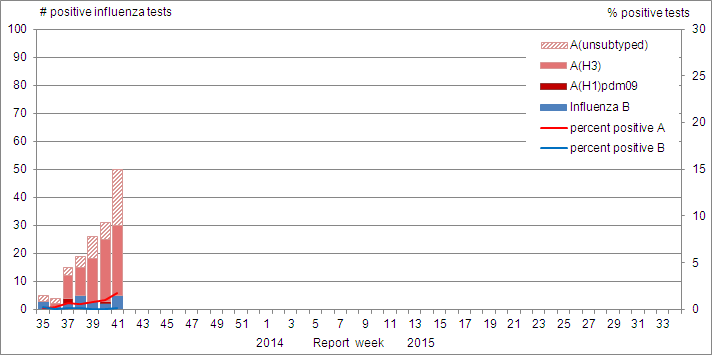
Figure 2 - Text Description
The number of positive influenza tests continued to increase in week 41 to 50 influenza detections (1.7% of tests).
In week 41, detections of some respiratory viruses were at inter-seasonal levels (human metapneumovirus) or in keeping with their usual pattern of seasonal circulation (RSV, parainfluenza, and coronavirus). Detections of adenovirus were higher than in previous seasons. Detections of rhinovirus seem to have peaked in week 39 at a level higher than observed in previous seasons, but decreased over the past two weeks (figure 3).
For more details, see the weekly Respiratory Virus Detections in Canada Report.
Figure 3. Number of positive laboratory tests for other respiratory viruses by report week, Canada, 2014-15
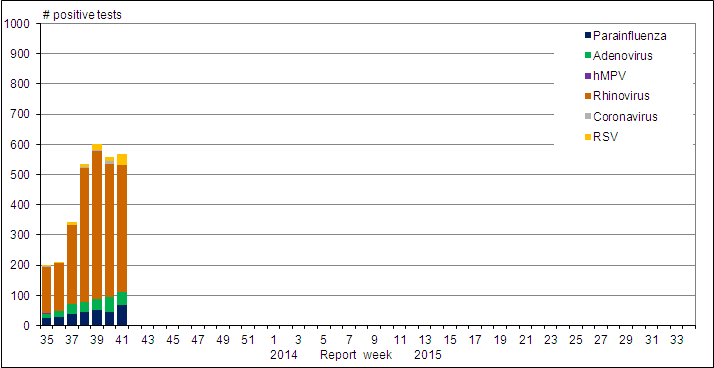
RSV: Respiratory syncytial virus; hMPV: Human metapneumovirus
Figure 3 - Text Description
In week 41, detections of some respiratory viruses were at inter-seasonal levels (human metapneumovirus) or in keeping with their usual pattern of seasonal circulation (RSV, parainfluenza, and coronavirus). Detections of adenovirus were higher than in previous seasons. Detections of rhinovirus seem to have peaked in week 39 at a level higher than observed in previous seasons, but decreased over the past two weeks.
| Reporting provincesFootnote 1 | Weekly (October 5 to October 11, 2014) | Cumulative (August 24 to October 11, 2014) | ||||||||
|---|---|---|---|---|---|---|---|---|---|---|
| Influenza A | B | Influenza A | B | |||||||
| A Total | A(H1)pdm09 | A(H3) | A Footnote (Uns) | B Total | A Total | A(H1)pdm09 | A(H3) | A(UnS) | B Total | |
| BC | 25 | 0 | 17 | 8 | 0 | 49 | 2 | 35 | 12 | 2 |
| AB | 10 | 0 | 6 | 4 | 3 | 40 | 0 | 34 | 6 | 7 |
| SK | 0 | 0 | 0 | 0 | 0 | 2 | 0 | 0 | 2 | 0 |
| MB | 0 | 0 | 0 | 0 | 1 | 1 | 0 | 1 | 0 | 1 |
| ON | 5 | 0 | 0 | 5 | 0 | 17 | 0 | 0 | 17 | 6 |
| QC | 5 | 0 | 0 | 5 | 0 | 17 | 0 | 0 | 17 | 6 |
| NB | 0 | 0 | 0 | 0 | 0 | 0 | 0 | 0 | 0 | 0 |
| NS | 0 | 0 | 0 | 0 | 0 | 0 | 0 | 0 | 0 | 0 |
| PE | 0 | 0 | 0 | 0 | 0 | 1 | 0 | 0 | 0 | 0 |
| NL | 0 | 0 | 0 | 0 | 1 | 0 | 0 | 0 | 0 | 0 |
| Canada | 45 | 0 | 25 | 20 | 5 | 129 | 3 | 81 | 45 | 21 |
| Percentage Footnote 2 | 90.0% | 0.0% | 55.6% | 44.4% | 10.0% | 86.0% | 2.3% | 62.8% | 34.9% | 14.0% |
| Age groups (years) | Weekly (October 5 to October 11, 2014) | Cumulative (August 24 to October 11, 2014) | ||||||||||
|---|---|---|---|---|---|---|---|---|---|---|---|---|
| Influenza A | B | Influenza A | B | Influenza A and B | ||||||||
| A Total | A(H1) pdm09 | A(H3) | A Footnote (Uns) | Total | A Total | A(H1) pdm09 | A(H3) | A (UnS) | Total | # | % | |
| <5 | 4 | 0 | 2 | 2 | 2 | 11 | 2 | 5 | 4 | 7 | 18 | 12.3% |
| 5-19 | 0 | 0 | 0 | 0 | 1 | 11 | 0 | 6 | 5 | 3 | 14 | 9.6% |
| 20-44 | 1 | 0 | 1 | 0 | 0 | 9 | 0 | 1 | 8 | 1 | 10 | 6.8% |
| 45-64 | 4 | 0 | 1 | 3 | 0 | 16 | 0 | 5 | 11 | 6 | 22 | 15.1% |
| 65+ | 14 | 0 | 4 | 10 | 1 | 78 | 1 | 38 | 39 | 4 | 82 | 56.2% |
| Unknown | 0 | 0 | 0 | 0 | 0 | 0 | 0 | 0 | 0 | 0 | 0 | 0.0% |
| Total | 23 | 0 | 8 | 15 | 4 | 125 | 3 | 55 | 67 | 21 | 146 | 100.0% |
| PercentageFootnote 2 | 85.2% | 0.0% | 34.8% | 65.2% | 14.8% | 85.6% | 2.4% | 44.0% | 53.6% | 14.4% | ||
Influenza Strain Characterizations
The National Microbiology Laboratory (NML) has not yet reported any influenza strain characterizations for the 2014-15 season (Figure 4).
Figure 4. Influenza strain characterizations, Canada, 2014-2015, N = 2
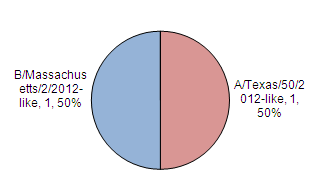
The NML receives a proportion of the number of influenza positive specimens from provincial laboratories for strain characterization and antiviral resistance testing. Characterization data reflect the results of haemagglutination inhibition (HAI) testing compared to the reference influenza strains recommended by WHO.
The recommended components for the 2014-2015 northern hemisphere trivalent influenza vaccine include: an A/California/7/2009(H1N1)pdm09-like virus, an A/Texas/50/2012 (H3N2)-like virus, and a B/Massachusetts/2/2012-like virus (Yamagata lineage). For quadrivalent vaccines, the addition of a B/Brisbane/60/2008-like virus is recommended.
Figure 4 - Text Description
| Strain | Number of specimens | Percentage |
|---|---|---|
| A/Texas/50/2012-like | 1 | 50% |
| reduced titres to A/Texas/50/2012 | 0 | 0% |
| A/California/07/2009-like | 0 | 0% |
| reduced titres to A/California/07/2009 | 0 | 0% |
| B/Massachusetts/2/2012-like | 1 | 50% |
| B/Brisbane/60/2008-like | 0 | 0% |
Antiviral Resistance
During the 2014-2015 influenza season, NML has tested 2 influenza viruses for resistance to oseltamivir and zanamivir and both were sensitive to both agents. The one influenza A virus tested for amantadine resistance was resistant (Table 3).
| Virus type and subtype | Oseltamivir | Zanamivir | Amantadine | |||
|---|---|---|---|---|---|---|
| # tested | # resistant (%) | # tested | # resistant (%) | # tested | # resistant (%) | |
| A (H3N2) | 1 | 0 | 1 | 0 | 1 | 1 (100%) |
| A (H1N1) | 0 | 0 | 0 | 0 | 0 | 0 |
| B | 1 | 0 | 1 | 0 | NATable 3 - Footnote * | NA Table 3 - Footnote * |
| TOTAL | 2 | 0 | 2 | 0 | 1 | 1 |
Influenza-like Illness (ILI) Consultation Rate
The national influenza-like-illness (ILI) consultation rate continued to increase, and was 31.6 per 1,000 consultations in week 41 (Figure 5). The rates since mid-June have been above the expected range for this time of year.
Figure 5. Influenza-like-illness (ILI) consultation rates by report week, compared to the 1996-97 through to 2012-13 seasons (with pandemic data suppressed), Canada, 2014-2015
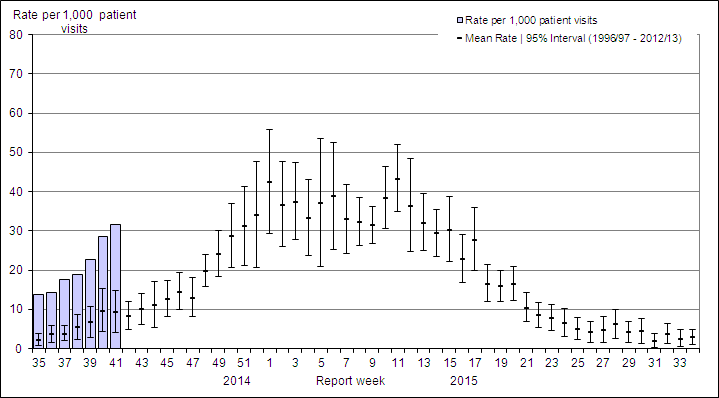
No data available for mean rate for weeks 19 to 39 for the 1996-1997 through 2002-2003 seasons. Delays in the reporting of data may cause data to change retrospectively. The calculation of the average ILI consultation rate over 17 seasons was aligned with influenza activity in each season. In BC, AB, and SK, data is compiled by a provincial sentinel surveillance program for reporting to FluWatch. Not all sentinel physicians report every week.
Figure 5 - Text Description
The national influenza-like-illness (ILI) consultation rate continued to increase, and was 31.6 per 1,000 consultations in week 41. The rates since mid-June have been above the expected range for this time of year.
Influenza Outbreak Surveillance
In week 41, one new outbreak of influenza B was reported in a long-term care facility (Figure 6).
Figure 6: Overall number of new laboratory-confirmed influenza outbreaks by report week, Canada, 2014-2015
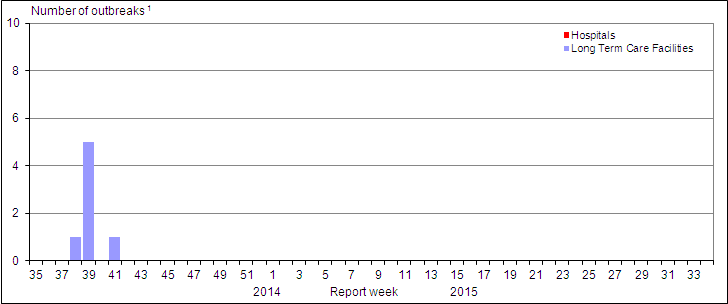
1 All provinces and territories except NU report outbreaks in long-term care facilities. All provinces and territories with the exception of NU and QC report outbreaks in hospitals. Outbreaks of influenza or influenza-like-illness in other facilities are reported to FluWatch but reporting varies between jurisdictions. Outbreak definitions are included at the end of the report.
Figure 6 - Text Description
| Report week | Hospitals | Long Term Care Facilities |
|---|---|---|
| 35 | 0 | 0 |
| 36 | 0 | 0 |
| 37 | 0 | 0 |
| 38 | 0 | 1 |
| 39 | 0 | 5 |
| 40 | 0 | 0 |
| 41 | 0 | 1 |
Pharmacy surveillance
During week 41, the proportion of prescriptions for antivirals was approximately 11 antiviral prescriptions per 100,000 total prescriptions, which is in keeping with previous seasons (Figure 7).
Figure 7. Proportion of prescription sales for influenza antivirals by age-group and week, Canada, 2014-15
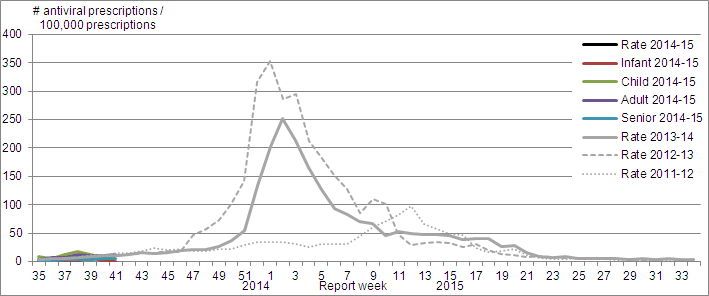
Note: Pharmacy sales data are provided to the Public Health Agency of Canada by Rx Canada Inc. and sourced from major retail drug chains representing over 2,500 stores nationwide (excluding Nunavut) in 85% of Health Regions. Data provided include the number of new antiviral prescriptions (for Tamiflu and Relenza) and the total number of new prescriptions dispensed by Province/Territory and age group. Age-groups: Infant: 0-2y, Child: 2-18y; Adult: 19-64y, Senior: ≥65y
Figure 7 - Text Description
Proportion of antiviral prescriptions per 100,000 total prescriptions in week 41 for the current season compared to previous seasons:
2014-15: 10.6; 2013-14: 10.4; 2012-13: 10.3; 2011-12: 14.6
Proportion of antiviral prescriptions by age-group in week 41 for the 2014-15 season:
Infant: 0.0; child: 10.3; adult: 12.9; senior: 5.2
Sentinel Hospital Influenza Surveillance
Paediatric Influenza Hospitalizations and Deaths (IMPACT)
In week 41, two new laboratory-confirmed influenza-associated paediatric (≤16 years of age) hospitalizations were reported by the Immunization Monitoring Program Active (IMPACT) network (Figure 8a). To date this season, seven hospitalizations have been reported by the IMPACT network, all cases of influenza A, and four of the seven were A(H3N2) (Table 4). To date, two cases were admitted to the ICU (Figure 9a).
Note: The number of hospitalizations reported through IMPACT represents a subset of all influenza-associated paediatric hospitalizations in Canada. Delays in the reporting of data may cause data to change retrospectively.
Adult Influenza Hospitalizations and Deaths (PCIRN)
Surveillance of laboratory-confirmed influenza-associated adult (≥16 years of age) hospitalizations by the PHAC/CIHR Influenza Research Network (PCIRN) Serious Outcomes Surveillance (SOS) network has not yet begun for the 2014-15 season (Figure 8b).
Note: The number of hospitalizations reported through CIRN represents a subset of all influenza-associated adult hospitalizations in Canada. Delays in the reporting of data may cause data to change retrospectively.
| Age groups | Cumulative (Aug. 24, 2014 to September 6, 2014) | |||||
|---|---|---|---|---|---|---|
| Influenza A | B | Influenza A and B | ||||
| A Total | A(H1) pdm09 | A(H3) | AFootnote (Uns) | Total | # (%) | |
| 0-5m | 0 | 0 | 0 | 0 | 0 | 0(0%) |
| 6-23m | 2 | 1 | 1 | 0 | 0 | 2 (29%) |
| 2-4y | 3 | 0 | 1 | 2 | 0 | 3 (43%) |
| 5-9y | 1 | 0 | 1 | 0 | 0 | 1 (14%) |
| 10-16y | 1 | 0 | 1 | 0 | 0 | 1 (14%) |
| Total | 7 | 1 | 4 | 2 | 0 | 7 |
| % Footnote 1 | 100.0% | 14.3% | 57.1% | 28.6% | 0.0% | 100.0% |
Table 5 - Cumulative numbers of adult hospitalizations with influenza reported by the PCIRN-SOS network, Canada, 2014-15
Figure 8 - Number of cases of influenza reported by sentinel hospital networks, by week, Canada, 2014-15
A) Paediatric hospitalizations (≤16 years of age, IMPACT)
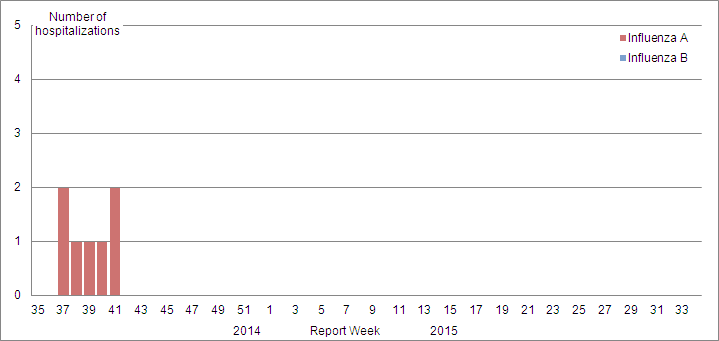
Figure 8A - Text Description
| Report week | Influenza A | Influenza B |
|---|---|---|
| 35 | 0 | 0 |
| 36 | 0 | 0 |
| 37 | 2 | 0 |
| 38 | 1 | 0 |
| 39 | 1 | 0 |
| 40 | 1 | 0 |
| 41 | 2 | 0 |
B) Adult hospitalizations (≥16 year of age, PCIRN-SOS)
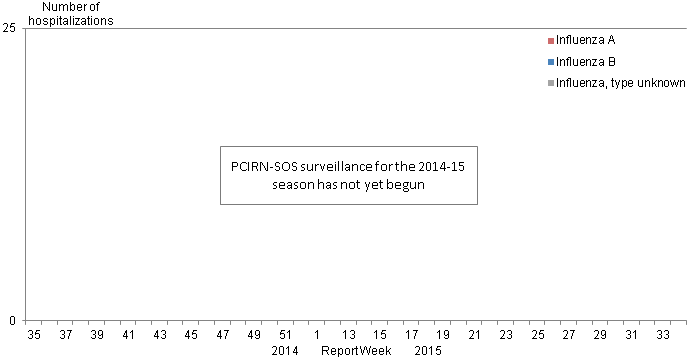
Figure 8B - Text Description
PCIRN-SOS surveillance for the 2014-15 season has not yet begun.
Figure 9 - Percentage of hospitalizations, ICU admissions and deaths with influenza reported by age-group, Canada, 2014-15
A) Paediatric hospitalizations (≤16 years of age, IMPACT)

Figure 9A - Text Description
| Age-group (years) | Hospitalizations (n=7) | ICU admissions (n=2) |
|---|---|---|
| 0-5m | 0.0% | 0.0% |
| 6-23m | 28.6% | 0.0% |
| 2-4y | 42.9% | 50.0% |
| 5-9y | 14.3% | 0.0% |
| 10-16y | 14.3% | 50.0% |
Figure 9 - Percentage of hospitalizations, ICU admissions and deaths with influenza reported by age-group, Canada, 2014-15
B) Adult hospitalizations (≥16 year of age, PCIRN-SOS)
PCIRN-SOS surveillance for the 2014-15 season has not yet begun.
Provincial/Territorial Influenza Hospitalizations and Deaths
Since the start of the 2014-15 season, 25 laboratory-confirmed influenza-associated hospitalizations have been reported from participating provinces and territoriesFootnote *, 24 were cases of influenza A, of which the majority were A(H3N2); 56% were patients ≥65 years of age. No ICU admissions were reported. Two deaths with influenza A(H3N2) have been reported in adults ≥45 years of age. There is a reporting delay from some regions that have not yet begun surveillance and/or submission of weekly reports.
| Age groups | Cumulative (24 August 2014 to 11 October 2014) | |||||
|---|---|---|---|---|---|---|
| Influenza A | B | Influenza A and B | ||||
| A Total | A(H1) pdm09 | A(H3) | AFootnote (Uns) | Total | # (%) | |
| 0-4 years | 2 | 0 | 1 | 1 | 0 | 2 (8%) |
| 5-19 years | 3 | 0 | 3 | 0 | 0 | 3 (12%) |
| 20-44 years | 1 | 1 | 0 | 0 | 0 | 1 (4%) |
| 45-64 years | 4 | 0 | 4 | 0 | 1 | 5 (20%) |
| 65+ years | 14 | 0 | 9 | 5 | 0 | 14 (56%) |
| Unknown | 0 | 0 | 0 | 0 | 0 | 0 (0%) |
| Total | 24 | 1 | 17 | 6 | 1 | 25 |
| Percentage Footnote 1 | 96.0% | 4.2% | 70.8% | 25.0% | 4.0% | 100.0% |
See additional data on Reported Influenza Hospitalizations and Deaths in Canada: 2009-10 to 2014-15 on the Public Health Agency of Canada website.
Emerging Respiratory Pathogens
Human Avian Influenza
Influenza A(H7N9): No new cases of human infection with influenza A(H7N9) have been reported by the World Health Organization since the last FluWatch report. Globally to October 16, 2014, the WHO has been informed of a total of 453 laboratory-confirmed human cases with avian influenza A(H7N9) virus, including 175 deaths.
Documents related to the public health risk of influenza A(H7N9), as well as guidance for health professionals and advice for the public is updated regularly on the following websites:
PHAC - Avian influenza A(H7N9)
WHO - Avian Influenza A(H7N9)
Middle East Respiratory Syndrome Coronavirus (MERS-CoV)
Globally, from September 2012 to October 16, 2014, the WHO has been informed of a total of 877 laboratory-confirmed cases of infection with MERS-CoV, including 317 deaths. Since the last FluWatch report, 19 new cases have been identified during a retrospective review of hospital records. All cases have either occurred in the Middle East or have had direct links to a primary case infected in the Middle East. The public health risk posed by MERS-CoV in Canada remains low (see the PHAC Assessment of Public Health Risk).
Documents related to the public health risk of MERS-CoV, as well as guidance for health professionals and advice for the public is updated regularly on the following websites:
Enterovirus D68 (EV-D68)
Information related to enterovirus D68, as well as guidance for health professionals and advice for the public is updated regularly:
International Influenza Reports
- World Health Organization influenza update
- World Health Organization FluNet
- WHO Influenza at the human-animal interface
- Centers for Disease Control and Prevention seasonal influenza report
- European Centre for Disease Prevention and Control - epidemiological data
- South Africa Influenza surveillance report
- New Zealand Public Health Surveillance
- Australia Influenza Report
- Pan-American Health Organization Influenza Situation Report
FluWatch definitions for the 2014-2015 season
Abbreviations: Newfoundland/Labrador (NL), Prince Edward Island (PE), New Brunswick (NB), Nova Scotia (NS), Quebec (QC), Ontario (ON), Manitoba (MB), Saskatchewan (SK), Alberta (AB), British Columbia (BC), Yukon (YT), Northwest Territories (NT), Nunavut (NU).
Influenza-like-illness (ILI): Acute onset of respiratory illness with fever and cough and with one or more of the following - sore throat, arthralgia, myalgia, or prostration which is likely due to influenza. In children under 5, gastrointestinal symptoms may also be present. In patients under 5 or 65 and older, fever may not be prominent.
ILI/Influenza outbreaks
- Schools:
-
Greater than 10% absenteeism (or absenteeism that is higher (e.g. >5-10%) than expected level as determined by school or public health authority) which is likely due to ILI.
Note: it is recommended that ILI school outbreaks be laboratory confirmed at the beginning of influenza season as it may be the first indication of community transmission in an area. - Hospitals and residential institutions:
- two or more cases of ILI within a seven-day period, including at least one laboratory confirmed case. Institutional outbreaks should be reported within 24 hours of identification. Residential institutions include but not limited to long-term care facilities ( LTCF) and prisons.
- Workplace:
- Greater than 10% absenteeism on any day which is most likely due to ILI.
- Other settings:
- two or more cases of ILI within a seven-day period, including at least one laboratory confirmed case; i.e. closed communities.
Note that reporting of outbreaks of influenza/ILI from different types of facilities differs between jurisdictions.
Influenza/ILI activity level
1 = No activity: no laboratory-confirmed influenza detections in the reporting week, however, sporadically occurring ILI may be reported
2 = Sporadic: sporadically occurring ILI and lab confirmed influenza detection(s) with no outbreaks detected within the influenza surveillance region Footnote †
3 = Localized:
- evidence of increased ILIFootnote * and
- lab confirmed influenza detection(s) together with
- outbreaks in schools, hospitals, residential institutions and/or other types of facilities occurring in less than 50% of the influenza surveillance regionFootnote †
4 = Widespread:
- evidence of increased ILIFootnote * and
- lab confirmed influenza detection(s) together with
- outbreaks in schools, hospitals, residential institutions and/or other types of facilities occurring in greater than or equal to 50% of the influenza surveillance regionFootnote †
Note: ILI data may be reported through sentinel physicians, emergency room visits or health line telephone calls.
